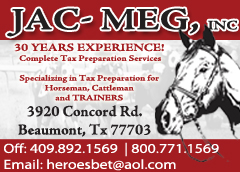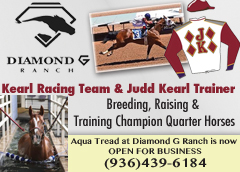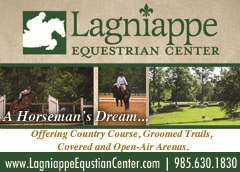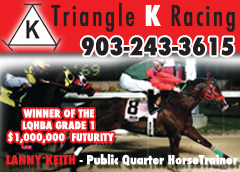Written by Barbara Newtown
Original Publish Date December 2013
Karen O’Connor, five-time Olympian in the sport of three-day eventing (dressage, cross-country jumping, and stadium jumping), gave a clinic at Holly Hill Farm in Benton, Louisiana, this November. Her number one message? Safety.
Karen has seen the sport of eventing change over the years. In the past, you could win a medal with a brave, forward horse, even if your dressage was explosive or inaccurate, and even if you dropped a few rails in stadium. Nowadays the dressage requires a beautiful, accurate ride. The stadium requires a horse that can compress its frame and manage tight turns. And the “questions” asked in cross-country are so difficult that horse and rider must practice combinations, corners, skinnies, drops, ditches, and water hazards as if their lives depended on it.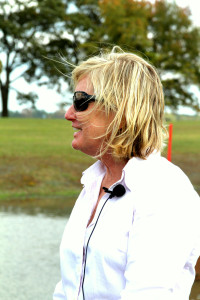
Lives do depend on practice. Cross-country jumps are solid, imposing obstacles. Instead of light rails, cross-country course designers use tree trunks, railroad ties, or telephone poles. Tables and ramps must be strong enough to support the full weight of a horse, if necessary. Often the horse cannot see what is on the other side. Every eventer fears the “rotational fall”: the horse fails to rise correctly, snags his knees on a solid jump, and flips. Even mistakes that could be minor—slipping a little on muddy ground, taking off too soon, not listening to the rider’s outside rein—become major at cross-country speed. Even the best eventers can be injured on cross-country. Karen herself is still recovering from fracturing two vertebrae a year ago. (Most people don’t realize that three-day eventing, the most dangerous sport in the Olympics, allows men and women to compete against each other equally.)
The catch-22 of eventing is that each phase takes a lifetime to learn. Not even the best dressage horse in the world ( Ahlerich in 1984, Totilas in 2012) has earned perfect scores for every movement. Open jumpers can always go a tad faster, a tad higher, a tad tighter. And cross-country course designers can always think up scary new “questions” that the horses have never seen before. Eventers must master all three phases.
Some critics of equestrian sport say that eventing is inherently too dangerous. However, Karen and her husband David (now coach of the U. S. Olympic eventing team) believe that proper training, proper equipment, and a skilled, honest horse make the sport manageable. Devotees of eventing accept risk proudly: the sport, after all, was developed in the 19th century as the ultimate test of the ideal military horse, a horse that was simultaneously brave and obedient, tough and sensitive, and fast and expressive. Anyone who has completed a cross-country course successfully, even at the lowest levels, knows the feeling of the horse galloping under you and saying, Yes, I understand what we’re doing out here, and I love it!
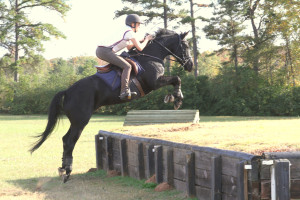 The most significant safety improvement in eventing is the compressed air vest. Connected to the saddle by a lanyard, the vest expands instantly when rider and horse are separated. Karen and David were early adopters of air vests and have urged their students to use them. (Although falling off is now safer than ever, the rules of eventing were recently changed: any fall that is caused by a jump requires that the rider exit the course and be evaluated by medical personnel. In the past a rider could remount and carry on without being checked out.)
The most significant safety improvement in eventing is the compressed air vest. Connected to the saddle by a lanyard, the vest expands instantly when rider and horse are separated. Karen and David were early adopters of air vests and have urged their students to use them. (Although falling off is now safer than ever, the rules of eventing were recently changed: any fall that is caused by a jump requires that the rider exit the course and be evaluated by medical personnel. In the past a rider could remount and carry on without being checked out.)
Karen and David have developed a system of riding that improves safety on cross-country. The horse depends totally on the brain and the ethics of its rider. The rider has four responsibilities: direction, speed, balance, and rhythm. The demands change as the skills develop: as Karen says, with a greenie the challenge of direction means just getting the horse to step into the arena. With an international competitor, direction is a matter of inches. Direction, speed, balance, and rhythm apply to dressage, stadium, and cross-country, but the four responsibilities become essential in the jumping phases, because of the addition of height and speed.
Karen starts out every clinic session, whether dressage or jumping, by having the riders lengthen and shorten their horses’ strides. Some can’t. Karen insists that a horse give some sort of answer when the rider makes a demand. Even if the “answer” is wrong—a break into canter when the rider is asking for a bigger trot, for instance—it still means that the horse hears its rider and the rider can therefore refine the aids to get the correct response. Karen blows her top when horses ignore their riders. “I didn’t see you do anything! The horse has to know you’re there!” Karen does not blame the horses. One time Karen chewed out a young rider for not making her cues “go through” the horse. The horse became more and more unruly. The rider burst into tears of frustration. Karen said, “It’s not about you….but it is your fault.”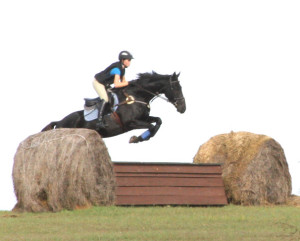
The mark of a “Karen rider”–someone who has taken enough of her clinics to absorb and apply her teaching—is the preparation before the cross-country jump. Between jumps on cross-country, you have to gallop to make the time. Karen recommends the two-point galloping position: seat out of the saddle, all your weight in the stirrups, and your upper body supported by reins in a single bridge at the withers. Ideally you can incorporate a turn seven or eight strides ahead of the jump at the end of the galloping stretch. In the turn, you settle into the saddle, feel the horse’s mouth, and ask the horse to shorten and bend his frame by pushing him from the inside leg to the outside rein. Then you flow forward to the jump, and keep your body elastic and moving. If direction, speed, balance, and rhythm are correct, the take-off spot is correct, and the horse has plenty of spring.
********
Bits of wisdom from Karen:
“If your horse is ignoring you, halt, squeeze your legs and back up, canter from the walk, repeat until the horse is light.”
“Imagine that your cues range from 1 to 10. Your “aid volume” should be a little as possible to get the result you want.”
“Don’t drag on the inside rein to make a turn. The outside rein turns the shoulders; the inside leg establishes the bend. Too much inside rein makes just the head turn; the shoulder pops out and you can’t engage the hindquarters.”
“Show me how slow you can canter. Push with your leg, hold with your reins.”
“The best way to improve position is to ride and jump without stirrups.”
“If you are prepared and calm, the whole world slows down, and you have time to make decisions.”
“As you approach the next jump, look sooner, see sooner, decide sooner.”
“Slow down—you’re coming in too hot!”
“You freeze in front of the jump and your horse doesn’t know what you want! Keep limber– row the boat and help your horse get there!”
“Going off course in show jumping or dressage happens after you have a bad moment—a rail down or an awkward transition—and your brain freezes.”
“Do all your work before the final approach.”
“Don’t throw your reins away over the fence. It’s OK over a six-foot wall, but it isn’t necessary over a three- or four-foot fence.”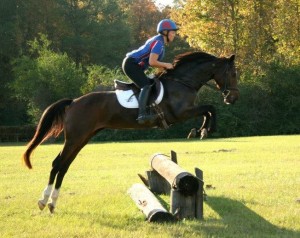 “Train your eye to see the take-off spot—it’s like going up stairs.” [David wants to hear his students counting strides out loud during the final approach to a jump: “One—two–three–four–” A rider might get to “three” or “five”; it doesn’t matter. But with repetition the rider becomes able to “see” the take-off spot—and sees it farther and farther out. The practiced eye can see the spot enough strides away from the fence for the rider to adjust the horse’s stride length and make the take-off perfect.]
“Train your eye to see the take-off spot—it’s like going up stairs.” [David wants to hear his students counting strides out loud during the final approach to a jump: “One—two–three–four–” A rider might get to “three” or “five”; it doesn’t matter. But with repetition the rider becomes able to “see” the take-off spot—and sees it farther and farther out. The practiced eye can see the spot enough strides away from the fence for the rider to adjust the horse’s stride length and make the take-off perfect.]
“When you get a bad take-off spot, keep your body down close to the horse and give with the reins.”
“If you can’t stop three strides in front of a jump, you are out of control.”
“Stop him! Don’t pull back on the reins. Run the bit through his mouth. The bit has to move faster than his brain can grab it. If you pull, everything freezes.”
“Your horse is racing at the jump because he thinks he has no other option and he’s desperate to get it done.”
“Don’t make a face—if you make a mistake, just start again.”
“To engage the hindquarters, do ring figures—circles, figure eights, diagonals—and lateral work—leg yields, shoulder-in. Your pattern needs to make sense for where the horse is in its education.”
“To collect, keep your upper body still and push with your seat and legs.”
“Dressage practice is practice for all three phases. When you’re not actually in the air over a jump, you’re still doing dressage.”
“Enjoy the journey—enjoy teaching the horse.”
********
When you take a lesson from Karen, you begin to understand that it is a privilege to participate in a sport in which perfection is impossible. It is also a privilege to ride a horse who has learned, from you, how to face the unknown with skill and zeal. The ideal event horse pricks up his ears in the start box and says, Let’s go, boss!

